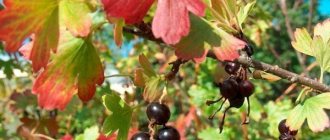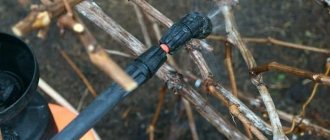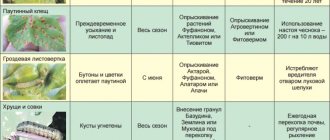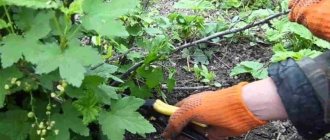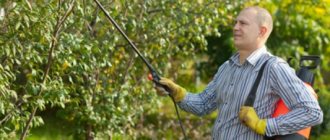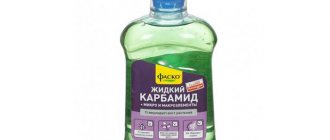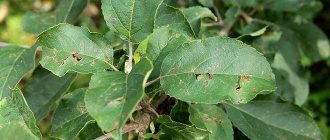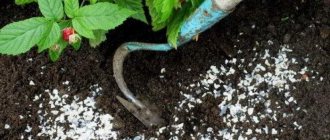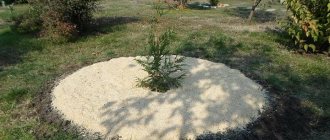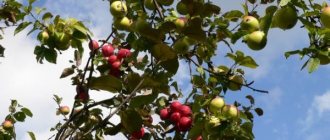How to treat currants in the fall against pests and diseases? In the fall, some summer residents, summing up the results of the harvest for the season, realize with bitterness that the results could have been much better if late blight had not attacked vegetables, scab had not attacked pears, aphids had not attacked peaches, and gray rot had not attacked currants. The sad list goes on.
And other gardeners are happy that the harvest turned out to be excellent; all the unused fruits over the summer are safely hidden in the cellars, canned, pickled, and turned into compotes and jams. They realize that only thanks to their work the plants were able to bloom together and bear fruit richly. And now the time is coming when next year’s harvest will depend on human actions.
Currants pureed with sugar for the winter without cooking
Why process currants in the fall?
Currants have long become a permanent inhabitant of gardens located in temperate regions. Gardeners have studied all the advantages of currant berries and leaves and use them for their own benefit. For food, not only fresh or dried parts of the plant are used, but also preparations are made from them. These are various types of compotes, jams, preserves, jellies, and fillings for confectionery products. Recipes for all kinds of marinades, vitamin teas, and medicinal mixtures are indispensable without currant leaves.
And if next year all this wealth is captured by leaf-eating insects or covered with red spots of rust and reddish cones of anthracnose, then the “forgetful” person who did not carry out preventive treatment of currants against pests and diseases in the fall will be to blame. After all, on the stems of currants, hidden under the wood peel and in the embryos of the buds, buried under the roots, pathogens and larvae of pests have settled down for the upcoming winter.
In the fall, treatments are carried out even if exactly the same ones were carried out in the spring. Indeed, during the periods of growing season, flowering, setting and ripening of fruits, currants will not only use up all their nutrient reserves, but will also waste all their strength and protective substances intended to fight microbes, viruses, and pests. Gardeners know that preventative autumn treatments increase next year’s currant yield by 25-30%.
How to treat a greenhouse in the fall after harvesting
The need for spring spraying of currants
This shrub, a relative of the gooseberry (they belong to the same family), can be found in every garden plot. Black, red and white currants are relatives, so for the most part they have common diseases and pests. Red and white currants are less susceptible to insect attacks and are less susceptible to infections than black currants, but also require mandatory spring treatment (see video).
After winter, all living things awaken, and not only plants, but also numerous insects that damage foliage, shoots, and roots of bushes. Pruning and spraying will get rid of potential pests and possible sources of infection. Care is the fight against diseases, pests, and preventive measures. But it’s easier to carry out prevention than to then treat berry plants and exterminate insidious beetles, ticks, and larvae.
Currants have many “enemies,” and the gardener has to protect the garden from aphids, scale insects, sawflies, and various types of mites. Serious damage to currant plantings is caused by glass beetle, honey borer, honey beetle, and bud moth. Some pests are also dangerous because they carry various viruses (for example, mites carry the currant reversion virus).
Early treatments are prevention against numerous bush diseases:
- spheroteca (American powdery mildew);
- rust (columnar, goblet);
- anthracnose;
- septoria;
- terryness.
Fungal disease spores, larvae and the pests themselves that survive the winter will be destroyed before the active phase, which means they will not be able to harm the berry bushes.
Processing times
How to treat currants in the fall against pests and diseases. In autumn, preventive work begins after removing the last berries from currant branches. Following the harvest and the leaves falling, the currants are pruned. After a few days, treatment with chemical and biological preparations begins. This usually happens in early autumn. The dates depend on the climatic conditions of the region and the timing of currant ripening.
Treatment calendar
Currant processing is carried out in early spring, in summer and in autumn, when the bushes are prepared for wintering.
in spring
The first treatment is carried out very early, after the snow has melted, but certainly before the buds bloom on the shoots. At this time, the bushes are treated against the following types of pests: mites, aphids, scale insects, leaf rollers and other leaf-eating and sucking pests.
At the stage of bud swelling, spraying is carried out against various spots and rust, as well as against ticks, moths and other caterpillars. When the flower buds begin to open (pink bud stage), they begin to spray the currant bushes a second time.
After the bushes have flowered and small ovaries have formed, they are treated again, especially against aphids, which may have colonized the bush by this time, as well as against powdery mildew.
In summer
In the summer, when the berries are growing and filling, but before harvesting, treatments are also carried out, only periodically. However, if chemical preparations were previously used, then during this period you should use biological or folk remedies. They are harmless and do not accumulate in plant tissues, fruits, or in the soil around currants. If you use chemicals, you must ensure that the last treatment is carried out no later than the waiting period specified in the instructions for use.
in autumn
The last treatment of the season is carried out after all the leaves have fallen off and the bush has prepared for wintering. The timing is different in each region, it can be October or November, but it must be taken into account that plants need to be processed at a temperature of at least 5°C.
How and how to properly treat currant bushes in the fall
Before starting preventive actions, thin out the currant bushes. Sanitary treatment consists of removing branches on which traces of disease were found during inspection. At the same time, thin, deformed shoots and root shoots that have grown into the bush, growing at a low height from the ground, are cut out.
Anti-aging treatment is carried out on bushes older than 3 years. On blackcurrant bushes, 4 two-year-old and 3-year-old shoots and 6 one-year-old shoots are left, the rest are cut out. On white and red currants, the old central stems are trimmed by 20 cm, but not completely cut out and most of the young shoots are removed, leaving at least 5 young branches.
Both types of pruning help get rid of various insect pests that usually live on weakened and old branches. They have limp, dry wood and weak pith. Regardless of the age of the shoots, branches damaged by insects and covered with putrefactive spots are removed. All cut branches are taken outside the site and burned. The work is carried out with sharp instruments, the wounds are covered with garden pitch.
How to get rid of aphids in the garden forever
After this, under the currant bushes, all fallen small wood and leaf debris, weeds are removed, the soil is loosened to a depth of 5 cm. Organic or mineral fertilizers are applied under the bushes, after the onset of persistent cold weather. This can be a bucket of rotted manure, 1 tablespoon of nitrophoska diluted in 10 liters, an aqueous solution of superphosphate and potassium phosphate (1 tablespoon per bucket of water).
Pests and diseases of currants
Shrubs are susceptible to damage depending on the variety. Let's look at what problems occur in well-known varieties of currants and gooseberries.
Aphid
Small insects settle in large clusters on leaves or other green parts of the crop, drinking the juices and killing the plant.
Gall aphid
The pest forms reddish swellings on the outer surface of the leaves. It most often affects red currants.
Shoot aphid
Insects damage the tops of young shoots. The pest can be recognized by the curled leaves of the bush. After removal, it is better to burn the affected parts so as not to infect healthy shoots.
Currant bud mite
This pest is a carrier of terry. The insect penetrates the kidney, causing it to increase in size. Affected vegetative organs are removed before opening. If there are not so many of them, then the plant can be saved. If most of the bush is damaged, the planting is removed.
Shields
Insects are difficult to detect because they have a color similar to the color of the branch. The pest adheres to the bark, sucks out beneficial juices, gradually leading to withering and drying out of the plant.
Fireflies, sawflies
Butterflies of these pests lay eggs in currant flowers. After the caterpillar eats a certain number of leaves, it pupates and produces a new generation. Moths often emerge from the soil after hibernation. Covering the ground with film before the currants bloom will help avoid this.
The sawfly parasitizes berries. Affected fruits should be immediately separated and burned.
Powdery mildew
A fungal disease whose spores are carried by the wind. When placed on shrubs they produce rapid growth. The leaves are covered with a white coating. If measures to combat the disease are not taken in time, the fungus spreads to the berries.
Chemical treatment methods for pests and diseases
How to treat currants in the fall against pests and diseases. For autumn treatment of currant bushes, gardeners have been using copper sulfate, karbofos, and iron sulfate for many years. These remedies have repeatedly proven their effectiveness. Moreover, when treated with iron sulfate, plants are saturated with useful microelements, bear fruit better, and become more resistant to diseases.
But, unfortunately, pathogens mutate over time, get used to treatments with familiar substances and do not always respond to their action. Therefore, gardeners began to add agents to copper or iron sulfate that increase their performance. Treatments are carried out in cold, dry, windless weather, this allows the substances to remain longer on the surface of the currant bushes.
Iodine for plants as fertilizer
Insecticides
The choice of drugs for killing insects is quite large. This allows you to use a new type with each treatment to prevent pests from becoming accustomed to the active ingredient of the product. To destroy pests overwintering on currant bushes, the drugs “Aktara”, “Confidor - Extra”, “Iskra”, “Inta-vir”, “Inta-Ts-M”, “Herold”, “Biotlin”, “Profilaktin” are used. "Fufanon", "Aliot Karate", "Zeon", "Kinmiks", "Aktellik".
Fungicides
Substances used to combat fungal diseases are classified as fungicides. They act directly on the bodies and spores of fungi, either by penetrating fungal cells or by blocking biochemical enzyme reactions. Since fungal spores are found everywhere - in the soil, in the air, and on the surfaces of all objects and plants, the use of these drugs is a necessary preventive measure. For currant processing, “Skor”, “Bayleton”, “Tilt”, “Prognoz” are used.
How to prepare fruit trees for winter
How to treat currants in spring against pests
Currants also have “too ardent admirers” among insects. They are capable of eating not only leaves and buds, but also roots and branches, leaving the bush no chance of salvation. Fortunately, with proper attention, they can be identified almost immediately after their appearance.
Currant pests
Most often, currant bushes are attacked by:
- kidney mite;
- bud moth;
- moth;
- glassware;
- currant aphid;
- currant borer;
- sawflies;
- currant gall midge.
- Pests of currants and gooseberries - photos, descriptions, how to treat the bushes
Find out how to protect your favorite berries from dangerous insects.
Means for early treatment of currants against pests
Means for treating currants against pests can be divided into folk (natural) and specialized (chemical). The first ones are good for prevention, but they can no longer cope with large-scale damage to the bush. Therefore, if you are a supporter of natural farming and do not want unnecessary drugs on the site, carefully and regularly inspect the bushes and do not forget about preventive treatments.
Such means can be used:
- boiling water (for treating currants against bud mites on frozen ground and unopened buds);
- soapy water;
- infusions of tobacco, celandine, garlic, onion peel, nightshade or dandelion (spraying currant bushes every 4-5 weeks, starting from the awakening of the buds and until harvest).
For those who realized it too late or want to act for sure, there are more serious remedies:
- colloidal sulfur solution (10 g of the drug per 10 liters of water);
- Bordeaux mixture (1% solution);
- Karbofos (powder or emulsion);
- Aktellik;
- Fufanon.
Biological agents for processing currants
How to treat currants in the fall against pests and diseases. Biological products are divided into substances that fight pests and drugs designed to destroy pathogens. The action of biological products is based on living organisms: antagonistic fungi, viruses, bacteria, beneficial insects. Therefore, many biological products only work until frost sets in. This must be taken into account so that treatments with these means do not turn out to be useless.
They use “Fitosporin”, “Pentafag”, “Mikosan”, “Alirib”, “Aktofit”, “Bitoxibacillin”, “Lepidotsid”, “Fitoverm”, “Kleschevit”. When using, follow the manufacturer's recommendations. Treatments are carried out in calm weather in the morning or evening. It should be remembered that the effect of the substances appears after a few days.
Fitosporin: how to use and why
Preparation for processing
Currant bushes can be treated for prevention or treatment, while spraying the plants completely or partially, that is, only damaged areas. For spring treatment and subsequent ones, use a spray bottle, sprinkling from a watering can, or, in the case of dusting with powder, use a strainer. 1 plant usually requires 1-1.5 liters of solution, the volume depends on its size. If you have to work with chemicals, you must use protective equipment: thick clothing, gloves and a mask so as not to breathe toxic fumes.
You need to spray it in the morning or evening, prepare the solution on the day of use, use it all up, if there is anything left, throw it away, you cannot store the leftovers.
We recommend reading
Technology for processing currants with boiling water in spring
How and what to feed currants in spring to get a high yield
Technology for pruning currants in spring and autumn, tips for beginners
Step-by-step instructions for planting currants in spring and autumn
Folk remedies for processing currant bushes
When using various herbal decoctions in the autumn, you can only achieve a repellent effect, and it is unlikely that you will be able to destroy the larvae of the pest hidden under the dense outer surface of the currant branches. Such treatments should be carried out before leaf fall, when insects are still active.
They use water infusions based on tobacco dust, garlic cloves, and onion peels. These herbal remedies can be used individually or made into mixed infusions. Add 200-250g of the selected substance or mixture to 10 liters of boiling water. Insist for 4 days. Strain and spray the currants, trying to get onto the lower part of the leaves. The same solutions are used to water the soil in the root area of currants.
How to make drip irrigation from plastic bottles with your own hands
Safety precautions when working with chemicals
Drugs that help in the fight for currant health can be harmful to the gardener. For the most part, they do not pose a mortal threat, but if ingested they can cause poisoning, headache, cough, burns of the mucous membranes and other troubles. Even when using folk remedies that are familiar to you, follow the rules:
- When scalding a bush with boiling water, take care of your feet and hold the watering can away from you at arm's length.
- Wear rubber gloves when handling chemicals.
- Make solutions in the fresh air.
- Keep open vials and ampoules with medications away from your face, and do not inhale over containers in which you dilute them. Use a gauze bandage or a respirator.
- Open glass ampoules by wrapping them in a napkin.
- Spray currants in calm weather.
- Keep children and pets away.
- If the solution gets on your skin, eyes, or mouth, stop treatment, wash, and rinse your mouth.
- After processing, throw away gloves, wash clothes, take a shower.
- Dispose of empty ampoules and packaging.
Video: safety precautions when spraying
Spring processing of currants is carried out in 2–3 stages. Before bud break, contact agents are suitable. Choose those that will save you from both diseases and pests. With the appearance of leaves, it is better to switch to systemic means. You should not select a different preparation for each pest and spray the same bush several times. It’s better to buy strong pesticides that can fight all types of pests at once. Also, one fungicide is enough to treat currants against all fungal diseases.
- Author: Marina Volkova
I live in Siberia. I have my own house and my own plot) In the articles I share my experience, I learn something myself together with you) Rate the article:
- 5
- 4
- 3
- 2
- 1
(7 votes, average: 4.3 out of 5)
Share with your friends!
Reviews
I believe that the most useful and effective way to process currants in the fall is to treat them with iron sulfate. Under the influence of this product, lichens, mushrooms, scab, anthracnose die, traces of downy and powdery mildew, and gray rot disappear. It reaches the larvae and eggs of pests. You just need to not just spray the currant bushes after it drops its leaves, but completely drench them. It is enough to dilute 500 g of iron sulfate in 10 liters of water. Pour the mixture into plastic bottles. A small stream of liquid flows out of them through the neck. It is convenient to pour over each individual branch.
Mikhail, Donetsk
I want to agree that iron sulfate is a very effective remedy. I will add that iron sulfate is mixed with water poured into a glass or plastic container; metal utensils cannot be used. And it cannot be mixed with lime. Copper sulfate is mixed with it - also a good remedy for processing currants in the fall.
Vladimir, Rostov
Natalia
Author
Ask a Question
Unfortunately, not all gardeners are of the opinion that autumn processing of currants is necessary. But bitter experience teaches a lot. I would like the mistakes not to be fatal, and the harvests to always be rich. Health to you and your loved ones!
Preparations for treatment
The plant can be treated with both chemical and biological preparations. The use of folk remedies gives a good effect.
When carrying out treatment, keep in mind that pests give preference to different types of currants. Black currants are most often attacked by borers, moths, and mites. And on the red and white - aphids and sawfly.
Before you start processing currant bushes, find out the weather forecast for the near future. If it starts to rain after spraying, all the preparations will be washed away and there will be no result. And also try to carry out processing in calm weather. I once started processing in a strong wind (there was no other opportunity) and treated myself instead of bushes.
Chemicals
Chemicals are very effective in controlling pests and diseases. At the same time, they are toxic and can cause harm to humans and the environment. Therefore, when using chemicals, strictly follow the instructions and apply at the appropriate time.
- 1% solution of Bordeaux mixture or 1% solution of copper sulfate - used for anthracnose, septoria, rust and other spots. Spraying is carried out as soon as the first leaves appear on the bushes. You can buy Bordeaux mixture ready-made or make it yourself. To prepare, dilute 100 g of copper sulfate and 100 g of lime in 10 liters of water.
- Iskra, Inta-CM, Karbotsin - against aphids, gall midges, leaf rollers, sawflies and moths. Used when flower buds begin to form. The greatest treatment efficiency is achieved when spraying in cool weather, below 15o.
- Karbofos, Actellik - against aphids, gall midges, leaf rollers, sawflies and moths. It is also used at the beginning of the formation of flower buds, but it is most effective to carry out the treatment at an air temperature of at least 15°.
- Akarin, Iskra-bio, Aktara - against currant bud mite, aphids, thrips, scale insects. Apply when leaves bloom and inflorescences appear. The greatest processing efficiency is achieved at a temperature of 24–25°. Repeated spraying can be done after flowering and after harvesting.
- Vectra, Strobi, Topaz, Thiovit Jet, colloidal sulfur - against powdery mildew, anthracnose and septoria. Treatment is carried out immediately after flowering. Effective at temperatures of 19° and above. Repeatedly after harvesting.
Biological drugs
The drugs are low-toxic and pose virtually no danger to people and animals. To effectively use biological drugs, carefully read the instructions for use.
- Lepidocide - against moth, currant moth, etc. Affects reproductive activity - parasites do not reproduce. Non-hazardous and environmentally friendly product. Used in dry weather, when the air temperature is not lower than 15o.
- Bitoxibacillin - against pests. It affects the intestines of insects - they cannot eat and die. Should not be used when the plant is flowering and bearing fruit. Spraying is carried out when the air temperature is 17o and above.
- Phytope - fights infection that causes plant diseases. In addition to protecting against infections, this drug is a humic fertilizer. Harmless and environmentally friendly product.
- Dendrobacillin - against pests that eat foliage. Acts on the intestines, parasites die after 2-3 days. It has no effect on codling moths and cutworms.
- Trichodermin - acts on microbes that cause disease. Improves growth and increases immunity in garden crops. An environmentally friendly product, it can be used when there are fruits on the bushes. The berries are picked even on the day of processing, you just need to wash them well. Effective at temperatures not lower than 14o.
- Fitosporin - effectively fights fungal and bacterial infections. The entire growing season is used, the crop is harvested even on the day of treatment. Use only in cloudy weather or in the evening, as the sun's rays kill beneficial bacteria.
Video: biological preparations for plant protection
Folk remedies
Gardeners successfully use folk remedies to protect currant bushes.
- Citrus infusion - used against aphids, scale insects, and mealybugs. You need to take 100 g of citrus peels and add 1 liter of water, leave for five days in a dark place. Spray at least three times with an interval of two weeks.
- Garlic infusion – against whiteflies, scale insects, mites and scale insects. Pour one head of garlic, pre-chopped, into 1 liter of boiling water and leave for seven days. Then dilute 50 ml of infusion in 10 liters of water and spray the bushes.
- Onion infusion - against aphids, thrips, mites; against diseases caused by fungi and bacteria. Pour one liter of chopped onion pulp into 1 liter of warm water and leave for a day with the lid closed. For spraying, dilute 20 ml of infusion in 10 liters of water.
- An infusion of tobacco leaves is used against leaf-sucking and leaf-eating insects. You need to take 1 kg of crushed tobacco leaves and stems and pour 10 liters of boiling water and leave for 24 hours. Add 10 liters of water and 80 g of grated laundry soap to 10 liters of infusion.
- Infusion of dry marigolds - against aphids, mites, whiteflies, thrips, fungal infections. Pour boiling water over dried marigold flowers and leaves in a 1:1 ratio and leave for two days. Strain the resulting infusion and spray the plants twice within a month.
- Soda solution - against powdery mildew, fungal infections. You need to add 50 g of soda to 10 liters of warm water. For effectiveness, add 50 g of grated laundry soap.
- Wood ash infusion - against powdery mildew. Pour one kilogram of wood ash into a bucket of water and leave for 4 days. Add 50 g of grated laundry soap to the solution. Spraying is carried out twice a month.
- Ammonia (ammonia solution) - against aphids. Dilute 50 g of grated laundry soap in 10 liters of water and add 30–40 g of ammonia. Treatment can be carried out during fruiting in June.
- A solution of soda ash with iodine - against aphids and powdery mildew. For 10 liters of water take 2 tablespoons of soda ash, 40 g of laundry or tar soap and 1 teaspoon of iodine.
- Vinegar - against insect pests. Add 2 tablespoons of vinegar essence to 10 liters of water and generously spray the bushes and water the soil under them.
Always plant marigolds and calendula around currant bushes. Pests do not like the specific smell of flowers, so they will avoid your bushes. These wonderful flowers grow everywhere in my garden. In addition to protecting many garden crops, they decorate the garden.
Boiling water treatment
The simplest and most effective way to get rid of pests in early spring is to pour boiling water over them. This method safely rids currants of bud mites, powdery mildew, and aphids. Boiling water also kills fungal spores that have spent the winter in the bark and soil. A plant that has experienced stress from exposure to hot water has improved immunity, increased productivity, and larger and tastier berries.
Pouring boiling water is carried out when the snow has not yet melted, until the kidneys wake up. Do not pour boiling water over 100°C! The watering temperature should be no more than 80o. When watering, it cools by another 10–20°, which is optimal for killing mites and fungal spores. Boiling water is poured into a watering can and each bush is thoroughly watered. Keep the watering can at a distance of about 10 cm from the branches. Douse the plant for no more than 5 seconds.
The advantage of dousing with boiling water is that it is the most environmentally friendly method of fighting infections and pests. It happens that the use of modern drugs does not solve the problem. Then only a spring dousing with boiling water will save the plant from parasites and infections.
Video: pouring boiling water over currants
You can use hot steam for processing. Under the currant bush, previously covered with film, you need to place a bucket of boiling water. Hot steam destroys bud mites and spores of fungal diseases that have overwintered on the branches. When the water has cooled to 70°, the film is removed.
Another method of protection is to treat the plant with fire from a torch or gas burner. This method is similar to treatment with boiling water or steam. Healthy currant buds are covered with strong leaves and are not afraid of fast open fire. And in loose buds, where there is a large accumulation of mites, their death occurs.
Treatment is carried out in early March, when the plants have not yet woken up. Without bringing the burner closer than 10 cm, we direct the fire along the branches and move it from top to bottom several times. Carry out the procedure very carefully so as not to burn the plant. This method destroys mites overwintering in the buds and aphid eggs.
When to spray, optimal timing
In 90-95% of cases, strict adherence to the schedule for processing and spraying currant bushes allows you to save the harvest.
So, when should these procedures be performed? The following time frames for the work are distinguished:
- The very first treatment of currants is carried out before the buds swell, which helps prevent the proliferation of all pathogenic bacteria that have settled in the shoots in the fall for wintering;
- The second treatment is carried out until the buds appear. In this case, all harmful parasites that did not have time to begin their vigorous life activity die;
- After the buds bloom, treatment is necessary to maintain the growth and ripening of the berries. It protects currant bushes from unfavorable environmental conditions. Spraying the bushes is carried out three times. The first time, after 10 days after the start of fruit formation. Then they take a break of 10 days and spray again.
Carefully! During the entire flowering period, currant bushes should not be sprayed with chemicals. As a result of such insect spraying, the crop may become unsuitable for food.
If for some reason the spraying procedures were not carried out on time, then the next spraying should not be done with an increased dose of chemical or biological preparations. You just need to treat the bushes as soon as possible to eliminate garden pests.
Based on this, timely processing of currant bushes within a clearly established time frame in early spring will be able to protect the crop from diseases and harmful insects and ultimately obtain beautiful and tasty berries.
Preparations for processing black, red and white currants Usually, processing different types of currants is no different from each other. After all, harmful insects settle on both black, white and red currant .
But there are parasites that prefer one type of currant to another:
- Zlatka, for example, chooses black currants ;
- Leaf aphids (gall aphids) and leaf sawflies prefer shoots of red and white shrubs;
- The bud moth does not tolerate black currants;
- The bud mite preferentially settles in black currants. It is rarely seen on red and white.
This must be remembered when processing and spraying black, red or white currants.
Red currant diseases: red spots
Often in summer, bright red spots can be seen on currant leaves, which can protrude above the leaf blade in tubercles (Figure 3).
This sign is a characteristic symptom of several diseases at once, which requires immediate control. Let's look at why red spots appear on currants and how to eliminate this pathology.
Causes
There are two reasons why shrub leaves become spotted. The first is the spread of the dangerous pest aphid, which forms entire colonies on plants and feeds on the juices of the crop. The second is anthracnose disease, and red spots indicate the initial stage of the lesion.
If you do not pay proper attention to this sign, the bush will gradually weaken and after a while die.
Symptoms
To determine exactly how to treat the plant, you need to carefully examine the bush to detect additional symptoms. If it has become a victim of aphids, the leaves will not only become covered with red spots, but will also become sticky from the insect's waste products. In addition, colonies of insects can be seen on young shoots and the undersides of leaves.
Figure 3. Currant disease - red spots on leaves
If anthracnose is the cause of the red spots, you should pay attention not only to the leaves themselves, but also to the berries and young shoots. Thin branches with this disease gradually become brown and dry out, and the berries become small and sour.
Treatment
The fight against red spots on bushes primarily depends on the cause of their formation. If they appear due to aphids, you need to carefully inspect the entire garden area and get rid of the ants that spread the pest.
Note: Without killing these insects, aphid control will only be temporary.
After destroying the ants, you need to immediately move on to fighting aphid colonies. To do this, the leaves can be washed with a solution of laundry soap or tobacco, but a more effective way is to spray the infected bush with special chemicals.
The fight against anthracnose is more complex and often takes more than one season. If you notice signs of disease in the fall, leave the bush for the winter and treat it with hot water in early spring. But, if red spots appear in the summer, you should not delay treatment until autumn or spring. The plants should be immediately sprayed with a solution of Bordeaux mixture, and all affected parts should be removed and burned.
Treatment of anthracnose
Anthracnose is a common disease of currants. Its danger is that in the initial stages of infection it is difficult to notice characteristic signs. Most gardeners determine that shrubs are infected with anthracnose only after the pathology has seriously spread (Figure 5).
Regardless of at what stage you notice the disease, you need to immediately begin treatment, since without fighting the disease, the shrub will first reduce its yield and then die.
Causes
Anthracnose can appear on any garden shrub. It is spread by insects and water, and can be found on weeds or garden tools.
Figure 5. Anthracnose symptoms
That is why, in order to prevent the spread of diseases, all equipment must be disinfected, as well as weeds must be removed between the bushes. In addition, in the spring it is necessary to water the bushes with hot water, which quickly destroys not only the causative agent of anthracnose, but also other pathological microorganisms, as well as pest larvae.
Symptoms
The first sign of anthracnose is the formation of small red-brown spots on the leaf blade. Gradually they increase in size and begin to cover the entire leaf.
With severe damage, all the leaves of the bush begin to acquire a brown tint, gradually dry out and fall off. Most often this happens in rainy weather. Moreover, the anthracnose pathogen successfully survives winter in the soil or under the bark, so without treatment, more serious signs of the disease may appear in the new season.
As soon as signs of the disease are detected, treatment should be started immediately. Firstly, in the spring, all last year’s leaves are removed from under the bushes and burned. Secondly, they spray with Bordeaux mixture (100 grams per 10 liters of water) and repeat the treatment after harvesting. In spring, you can spray the bushes with boiling water.
Diseases and pests
Currants are a tasty morsel for a huge number of different parasites and pathogenic bacteria. But before processing it, you need to clearly understand what ails the bush or who affected it.
The following pests are known to love to taste young leaves and juice of fruit crops:
- bud moth;
- kidney mite
- spider mite;
- aphids on shoots;
- gall aphid;
- scale insect;
- goldfish;
- sawfly;
- gooseberry moth.
There is also a list of the most common currant diseases:
- anthracnose;
- terry (reversion);
- powdery mildew;
- gray rot;
- white spot (septoria);
- mosaic;
- goblet and columnar rust;
- drying out of shoots.
The peak of diseases occurs in spring, when the bush grows, buds swell and leaves appear. Timely treatment of the bush will help reduce the risk of diseases and get an excellent harvest.
